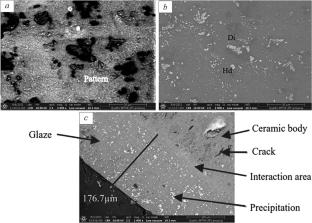Characterization of the Glass Structure of East Lampung's Scoria Basalt (Indonesia) Applied to the Ceramic Body
Abstract
The research was carried out to increase the added value of the basalt rock from East Lampung, Indonesia, by using it as a raw material for producing a glaze for earthenware ceramics. Basalt of scoria and basalt smelted at a temperature of 1,400°C mixed with local kaolin and feldspar from Lampung, Indonesia, with variations in the composition of basalt to kaolin and feldspar at 70 : 15 : 15, 50 : 25 : 25, and 30 : 35 : 35, respectively, was applied. The glazing process using the dip coating method was applied, followed by burning all samples at a temperature of 1,000°C. All samples were held for 8 hours at the specified temperature and cooled to room temperature. According to the results of determining the color properties of each sample it is determined that they depend on the iron content. It was established that the more of basalt in composition is used, the brighter the red color of the glaze becomes when crystallization grows due to the devitrification process during cooling. XRF analysis was conducted to determine the chemical composition of each composition to evaluate its effect on crystallization formed based on the XRD test. Furthermore, an SEM analysis was carried out to determine the topography and morphology of the glaze samples obtained. According to the analysis results, the natural basalt samples provide a topography of a bright and well-adhesive layer. In contrast, molten basalt gives a rough and opaque surface. It has significantly different results as the starting phase of each material has various structure forms, which are influenced by the forming glaze surface at 1,000°C. At the 2000 SEM magnification, samples with basalt scoria as based material tend to fuse with the main body of earthenware. It gives the glazed coating strong adhesion to stick to the earthenware surface. At the same time, molten basalt provides cavities and pores in the area of interaction between the main body and the glazed surface. The growing use of raw and melted basalt in the glaze layer provides a brighter red gradation, and the majority of the phase that happened was from the pyroxenic group and some wollastonites.


 求助内容:
求助内容: 应助结果提醒方式:
应助结果提醒方式:


